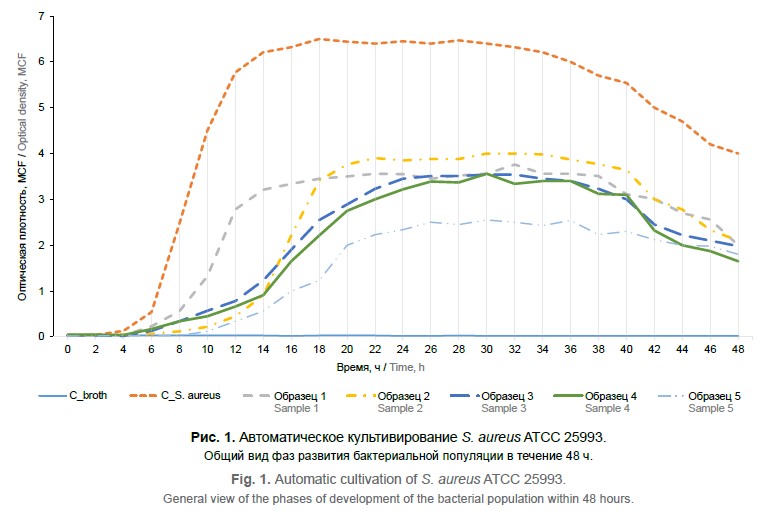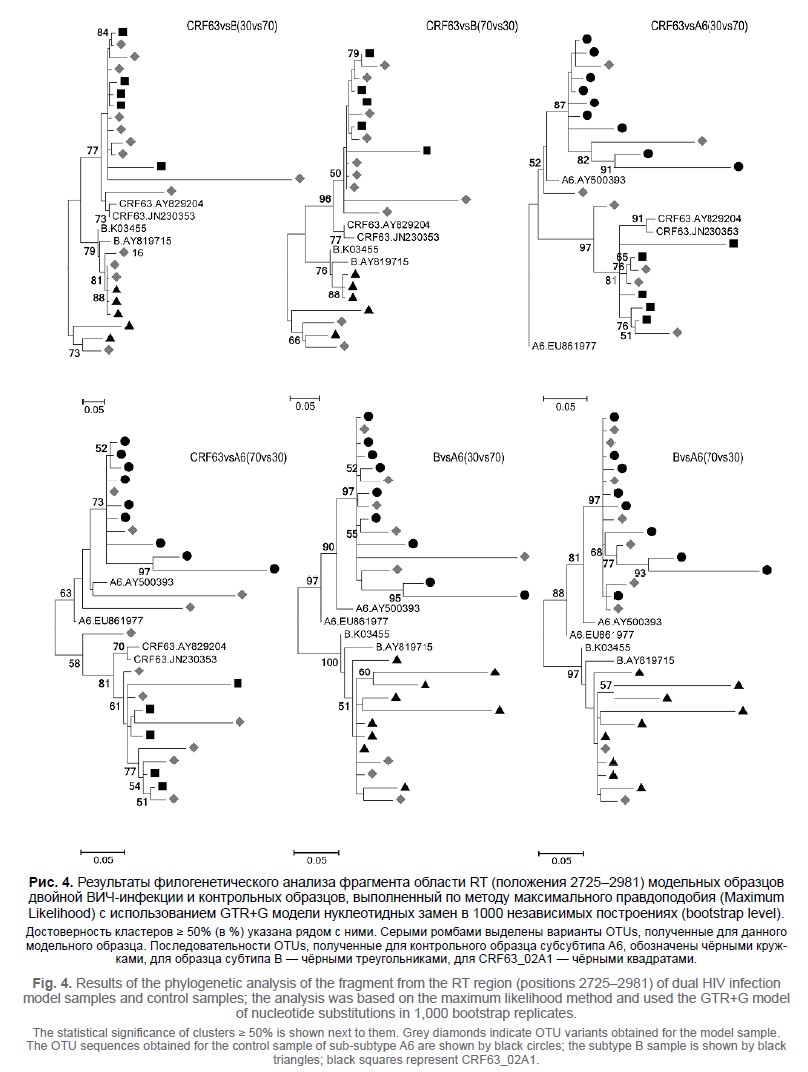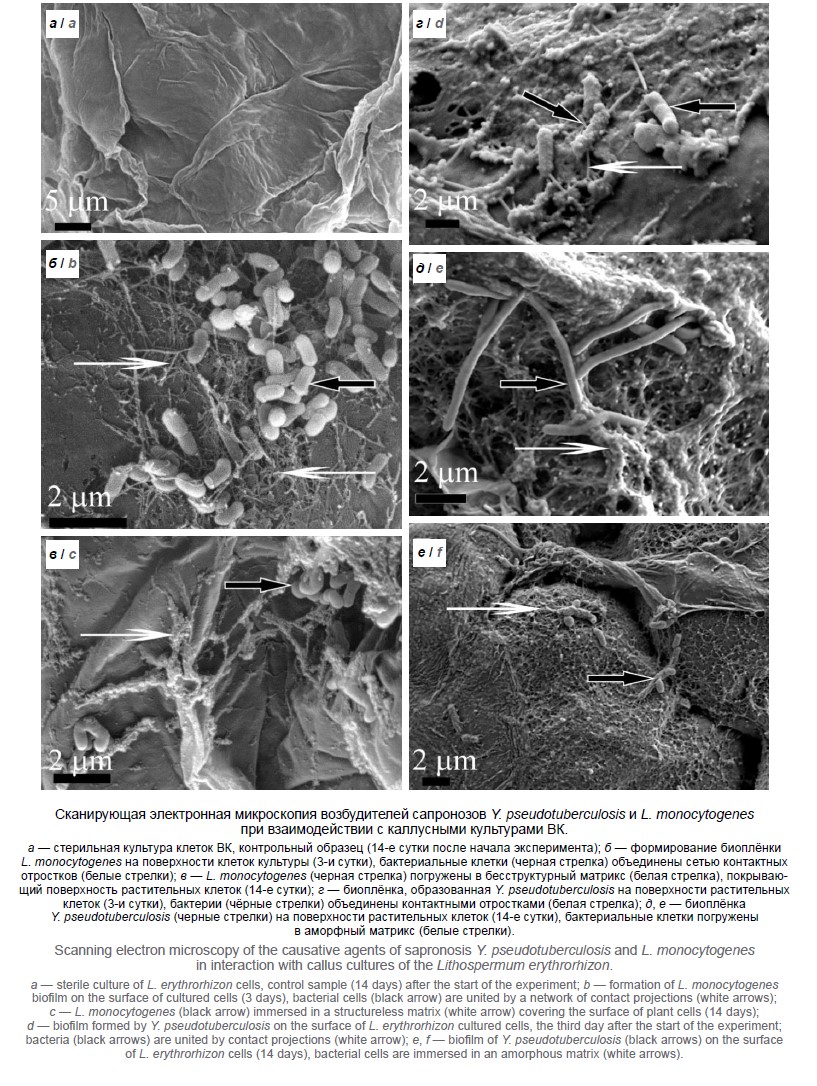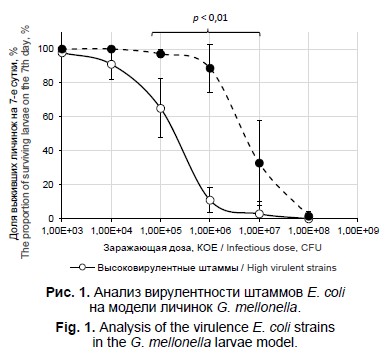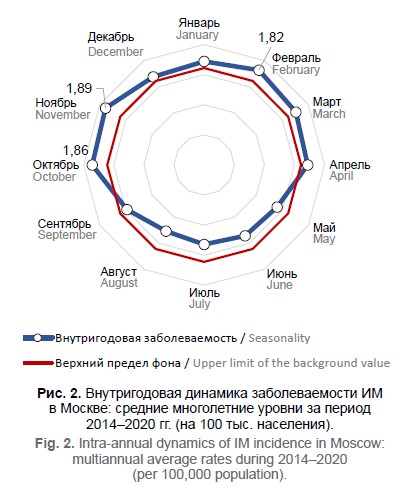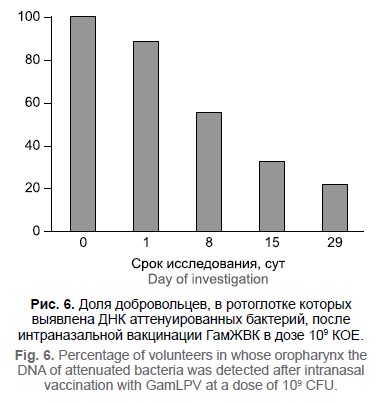Vol 98, No 6 (2021)
- Year: 2021
- Published: 10.01.2022
- Articles: 11
- URL: https://microbiol.crie.ru/jour/issue/view/47
Full Issue
ORIGINAL RESEARCHES
Method for the estimation of antibacterial activity of the polyfunctional protein from transferrin family in the experimental model of the kinetics of Staphylococcus aureus development
Abstract
Introduction. Lactoferrin is a cationic monomeric glycoprotein produced by acinar cells and glands, present in different places of the mucous membrane in different concentrations. In connection with the development of various variants of hygienic and medicinal products for the treatment of inflammatory diseases of the oral cavity based on lactoferrin, there was a need for an objective assessment of its antibacterial and antibiofilms properties, followed by an analysis of the preservation of activity in various variants of the isolation of this protein from the substrate and storage.
Aim - to improve the effectiveness of evaluating the antibacterial activity of lactoferrin and the duration of its preservation in various biological substrates containing the active substance and individual experimental batches of the manufactured drug using automatic cultivation.
Materials and methods. As part of the experiment, a microbiological diagnostic technique employing a system for the automatic cultivation of microbial populations was used. A pre-prepared bacterial suspension was inoculated into the nutrient broth and the studied lactoferrin samples were added, followed by cultivation and analysis of the possible antibacterial effects of transferrin protein. To determine the sensitivity of the isolated strains, we used our own modification of the serial dilution method developed at the Department of microbiology, virology, immunology of the A.I. Yevdokimov Moscow State University of Medicine and Dentistry. The experiment was based on the programmed automatic cultivation using the RTS-1 bioreactor. The interpretation of the results was carried out by changing the optical density at a wavelength of λ = 850 nm. The study of the growth dynamics of microorganisms was carried out in several repetitions, which was reflected in the graphs of the development of bacterial populations. The assessment of the growth control of the corresponding bacterial species was reflected in the change in the optical density values, on the basis of which the curve was built. Results and discussion. According to the results of an experimental study of the growth curves of bacterial populations, statistically significant differences in the number of viable cells in different phases of the growth curves were noted, when using different lactoferrin samples. Higher activity of human recombinant lactoferrin samples was established. An analysis of growth dynamics revealed differences in the onset of the maximum reproduction and its inhibition under the influence of various aggravating factors during cultivation. The bacteriostatic effect of lactoferrin is realized through the binding of iron ions, depriving the bacteria of this microelement, causing inhibition of their development. Along with this, lactoferrin is active against certain virulence factors of microorganisms, splitting them like serine proteases, and thus prevents their penetration into human cells.
Conclusion. The method used for automatic cultivation of microorganisms in the bioreactor used allows one to obtain reproducible results, is available for wide use, and can be recommended for obtaining objective, comparable, reliable information about the antimicrobial properties of various samples of the bactericidal protein lactoferrin produced by the domestic pharmaceutical industry. The studied substrate containing recombinant human lactoferrin of Russian production is characterized by high antibacterial activity that persists for 3 years as minimum.
 617-627
617-627


Application of next generation sequencing in dual HIV infection studies
Abstract
Introduction. The aim of the study was to use comparative analysis for assessing efficiency of detection and confirmation of dual HIV infection, using conventional population sequencing (PS) and next generation sequencing (NGS) for an HIV-1 pol gene fragment, which encompasses protease and partially reverse transcriptase (positions 2253–3368).
Materials and methods. The study was performed on intersubtype dual HIV infection model samples containing viruses of HIV-1 subtype B, sub-subtype A6 and recombinant form CRF63_02A1. Viruses were mixed pairwise in proportions from 10 to 90% to obtain 3 groups of model samples: CRF63vsB, CRF63vsA6, and A6vsB. The nucleotide sequences obtained by using PS and NGS technologies having 5, 10, 15, and 20% sensitivity thresholds for minor virus variants (NGS5–NGS20, respectively) were used to estimate the number of degenerate nucleotides or the degenerate base (DB) count and the number of synonymous mutations (SM) or the SM count. The fragment of the studied region (positions 2725–2981) was used for the analysis of operational taxonomic units.
Results. The application of NGS5 proved highly efficient for detection of dual HIV infection in the model samples. The statistically significant (p < 0.01) increase in DB and SM counts was demonstrated by NGS5 compared to PS. As a result, NGS5 helped detect dual HIV infection in 25 out of 27 model samples, while with PS it was detected only in 15 samples. The analysis of operational taxonomic units confirmed dual HIV infection in all the groups of model samples.
Discussion. The efficiency of detection and confirmation of dual HIV infection depends both on the content of each virus in the sample and on genetic characteristics of these viruses. Conclusion. Using NGS genetic testing in routine practice will be instrumental for efficient identification of genetic characteristics of infectious agents and for thorough analysis of the epidemiological situation.
 627-638
627-638


Phenotypic profile of priority multiresistant Аcinetobacter baumannii sequence types (ST 1167, ST 944, ST 208)
Abstract
Introduction. About 1,000,000 cases of infections caused by Acinetobacter spp. per year are registered globally, making up 1.8% of all the cases of hospital-acquired infections. In compliance with long-term studies carried out in in this country and abroad, Acinetobacter baumannii is a clinically important representative of the Acinetobacter genus. Intraspecific typing of microorganisms is an integral part of a clinical microbiologist's contribution to scoring the outbreaks of purulent-septic infections within the sphere of HAI surveillance. Most of the practicing microbiological laboratories cannot use genotypic typing methods because of their high costs.
Objective. Developing a test panel for intraspecific identification of A. baumannii sequence types (ST 1167, ST 944, ST 208) based on their phenotypic properties.
Materials and methods. Intraspecific membership of 74 A. baumannii strains obtained from four multipurpose health settings of a large industrial centre was studied using a genetic method (multilocus sequence typing) and a suite of phenotypic methods (biochemical tests, biofilmogenous capacity, growth inhibition zones to antibacterial drugs, sensitivity to aniline dyes, disinfectants and Acinetobacter bacteriophage) was studied.
Results. Phenotypic features of three predominant A. baumannii sequence types (ST 1167, 944, 208) were determined.
Discussion. An efficacious economy set of differentiating tests allowing identification of intraspecific features of A. baumannii multiresistant strains was сreated.
Conclusion. The test panel will enable the laboratories that cannot use sequencing methods to conduct intraspecific differentiation of common A. baumannii sequence types as part of microbiological monitoring.
 639-647
639-647


Development of specific immunity in laboratory animals after co-immunization against seasonal influenza and COVID-19
Abstract
Introduction. In clinical practice, the differential diagnosis of COVID-19 can be challenging during the flu season, entailing serious consequences such as delays in appropriate control measures against the SARS-CoV-2 pandemic. Another problem is posed by co-infection of SARS-CoV-2 and influenza virus (IV), which significantly contributes to the severity of the COVID-19 disease. This study was aimed to explore the cross-impact of co-administration of Russian influenza and COVID-19 vaccines on development of specific immunity in laboratory animals.
Materials and methods. The study was conducted on BALB/c mice. The animals were inoculated intramuscularly with the vaccine for COVID-19 prevention (CoviVac) and the vaccine for influenza prevention (Flu-M). The sera from the immunized animals were examined separately. Three IV strains were used in the hemagglutination inhibition assay. Antibodies (Abs) against SARS-CoV-2 were detected by an enzyme-linked immunosorbent assay (ELISA). The neutralization test was performed to detect virus neutralizing antibodies against SARS-CoV-2 and IV.
Results. Relatively high titers of specific Abs were found in the groups of animals inoculated with one vaccine and with two vaccines concurrently. In the groups of animals inoculated with CoviVac and with two vaccines concurrently, both in the ELISA test and in the neutralization test, the average titers of specific Abs against SARSCoV- 2 did not demonstrate any statistical difference. The group of animals inoculated concurrently with two vaccines demonstrated statistically higher titers of Abs against IV after the second immunization compared to the group of animals inoculated with Flu-M.
Discussion. The study has shown that post-vaccination immunity both to IV and to SARS-CoV-2 develops after co-vaccination with two vaccines. The observed enhanced post-vaccination immune response to IV in the coimmunized laboratory animals needs further research.
Conclusion. The performed studies suggest the possibility of co-administration of two vaccines to prevent influenza and COVID-19.
 648-656
648-656


Analysis of changes in the state of vaginal microflora in women of reproductive age under conditions of a three-day "dry" immersion without the use of prophylaxis
Abstract
Introduction. Currently, the participation of women in space flights is increasing. In this regard, questions about the influence of space factors on the state of the female body arise inevitably. Model experiments, in particular, "dry" immersion, are most convenient for studying the influence of individual factors of space flight on the organism. The aim of this work is a comparative assessment of the state of the vaginal microbiota of 6 female volunteers before and after three-day "dry" immersion.
Materials and methods. Microbial samples of all volunteers were stained according to Gram with a sequential culture study in accordance with the medical technology. The species identification of microorganisms was performed by MALDI-TOF-MS analysis using an Autoflex III time-of-flight mass spectrometer with Maldi BioTyper software.
To assess changes in the state of the vaginal microflora and microflora of the cervical canal, eubiotic index was used. It reflects the number of positive states of microbiota to the number of negative ones.
Results. After 3 days of "dry" immersion volunteers, who had high titer of aerobic microorganisms before isolation, had significant increase of the amount of aerobic microorganisms, while the number of lactobacilli decreased. The other group of volunteers showed activation of colonization resistance of the vaginal microflora. Volunteers, who had a significant contamination with anaerobic opportunistic microflora before isolation, had reduction of the number of all anaerobes, including lactobacilli. The eubiotic index, calculated for the cervical canal, decreased after 3 days of immersion. The data obtained indicate that after 3 days of isolation, the state of the microflora has deteriorated.
 657-663
657-663


Interaction of causative agents of sapronoses with the land plant Lithospermum erythrorhizon
Abstract
Background. A significant role in the ecology of the sapronotic pathogens Yersinia pseudotuberculosis and Listeria monocytogenes and in the epidemiology of the infections they cause is played by land plants used for food. These microorganisms are often found on plant substrates, they multiply on various vegetable and root crops. In this regard, it is relevant to study the viability and biological activity of Y. pseudotuberculosis and L. monocytogenes in contact with various land plants, including those that are not eaten, but are used in medicine.
Aim. Study of the interaction of sapronotic pathogens Y. pseudotuberculosis and L. monocytogenes with callus cultures of the land plant Lithospermum erythrorhizon Siebold et Zucc.
Materials and methods. The studies included strains of Y. pseudotuberculosis 512 serotype 1b, pYV+, 82MD+ and L. monocytogenes NCTC (4b) 10527 from the Collection of Somov Institute of Epidemiology and Microbiology, and cell culture from the roots of red-root gromwell Lithospermum erythrorhizon line VC-39 (from the Collection of FSC of the East Asia Terrestrial Biodiversity FEB RAS).
Before the study, Y. pseudotuberculosis and L . monocytogenes were cultured 18–20 hours on nutrient agar pH 7.1–7.2. A working dilution of microorganisms was prepared (106 micobial cells per 1 ml) and applied at a dose of 100 μl to the surface of plant calli. Material samples were taken in dynamics after 3 and 14 days and prepared for scanning electron microscopy.
Results. Y. pseudotuberculosis and L. monocytogenes formed biofilms on the surface of plant cells within 3 days after the start of the experiment. It was noted that Y. pseudotuberculosis destroyed the components of the plant cell membrane.
Conclusion. New data obtained during the study expand the understanding of environments and forms of habitation, as well as the potential for pathogenicity of sapronotic pathogens in the environment.
 664-670
664-670


Characterization of virulent Escherichia coli strains isolated from patients with urological infection
Abstract
Objective. Urinary tract infections (UTIs) caused by uropathogenic Escherichia coli (UPEC) affect 150 million people annually.
Purpose: Characteristics of non-hospital strains of UPEC isolated from patients with UTI in Yaroslavl in 2016– 2017.
Materials and methods. Susceptibility of UPEC strains (n = 20) to antibacterials was measured by the serial dilution method; the antibiotic resistance and virulence genes, phylogroups, O-serogroups and sequence types were identified by PCR and whole genome sequencing. The virulence of the strains was studied using the model of Galleria mellonella larvae.
Results. UPEC strains were classified as resistant (n = 11) and multi-drug resistant (n = 9) pathogens. Betalactamase genes blaTEM (n = 10), blaCTX-M (n = 6), class 1 integrons (n = 8), and gene cassettes dfrA17-aadA5 (n = 2), dfrA1 (n = 1) and aacA4-cmlA1 (n = 1) were identified. UPEC-virulence genetic determinants coding adhesins fimH, papG, sfaS, focG, afa/draBC, csgA, siderophores iroN, fyuA, iutA, counteracting factors of host immunity ompT, traT, toxins hlyA, cnf1, usp, capsule transporter kpsMTII, colicin cvaC, and pathogenicity islands I536, II536, III536, IV536, IIJ96 и IICFT073 were detected. Highly virulent and slightly virulent for G. mellonella larvae UPEC strains were obtained with LD50 104–105 and 106–107 CFU, respectively. The phylogroups A, B1, B2, E and F, serogroups О2, О4, О6, O9, O11, О15, О18, О25, О75 and O89, known sequence types ST14, ST58, ST69, ST73, ST93, ST127, ST131, ST-141, ST165, ST297, ST457, ST537, ST744, ST1434 and novel ST9239 and ST10102 were revealed.
Conclusions. The identified genetic diversity of non-hospital UPEC strains is consistent with the observed global trend in the spread of human pathogens, which are characterized with both high virulence and multiple drug resistance. This makes possible to assess prospectively the current epidemiological situation, give a forecast for its development in the future, as well as determine the optimal therapeutic options.
 671-684
671-684


Epidemiological characteristics of Epstein–Barr virus infection
Abstract
Introduction. The Epstein–Barr virus (EBV) is one of the most common pathogens — it infects 90% of the world’s population. However, specific characteristics of the EBV infection epidemic process remain unidentified. The previous studies focusing on assessment of incidence rates for infectious mononucleosis (IM) tend to ignore the serological status of the population.
The aim of the study was to identify epidemiological characteristics and assess the prevalence of serological markers for EBV infection for further epidemic control measures development.
Materials and methods. In Moscow, the thorough analysis was performed using the data on IM incidence (Form 2 "Data on Infectious and Parasitic Diseases") and test results for 138,232 people checked for presence of VCA IgG, EBNA IgG, VCA IgM, EA IgG, and EBV DNA in their blood and saliva in 2011–2020.
Results. The periodic pattern of IM incidence was discovered, demonstrating the repetitive peaks every 9 to 11 years and a strong direct correlative relationship with detection rates for active EBV infection markers. The intra-annual dynamics of IM incidence is characterized by a seasonal upswing during cold seasons of the year, reaching its peaks in October, November, or February and associated with a marked decrease in the VCA IgG and EBNA IgG seroprevalence. Children within the 1 to 17-year age range are groups at risk for acquiring primary infection, demonstrating significantly lower detection rates for chronic EBV infection (VCA IgG and EBNA IgG) markers and higher rates for VCA IgM and EBV DNA markers in blood compared to adults. The contribution of adult population to the epidemic process is formed through reactivation of chronic infection, which is observed primarily among women.
Conclusion. The identified characteristics are essential for comprehensive understanding of the EBV infection epidemic process and can be used for developing preventive and anti-epidemic measures.
 685-696
685-696


Drug susceptibility testing of Mycobacterium tuberculosis using next generation sequencing and Mykrobe software
Abstract
Introduction. Mycobacterium tuberculosis is the causative agent of tuberculosis. Drug susceptibility testing is performed by phenotypic and molecular tests. Commonly used for phenotypic drug susceptibility testing is the automated BACTEC system in a liquid culture medium. Drug susceptibility by line probe molecular tests was introduced almost 15 years ago. Recently whole genome sequencing (WGS) analysis of M. tuberculosis strains demonstrated that genotyping of drug-resistance could be accurately performed. Several software tools were developed.
Our study aimed to perform whole-genome sequencing on phenotypically confirmed multi-drug resistant (MDR) M. tuberculosis strains, to identify drug-resistant mutations and to compare whole-genome sequencing profiles with line probe assay and phenotypic results.
Materials and methods. We performed analysis on 34 MDR M. tuberculosis Bulgarian strains. Phenotypic drug susceptibility testing was performed on the BACTEC system. For molecular testing of drug susceptibility to first- and second-line tuberculostatics, we applied line probe assay Geno Type MTBDR plus v.1.0 и Geno Type MTBDR sl v.1.0. Sequencing was performed on MiSeq. Generated FASTQ files were analyzed for known drugresistant mutations with the software platform Mykrobe v.0.8.1.
Results. All three methods — phenotypic analysis using the BACTEC system, genetic analysis of strains applying the Geno Type test and Mykrobe software gave comparable sensitivity/resistance results for the studied strains. All phenotypically proven rifampicin and isoniazid-resistant strains were 100% confirmed using Mykrobe software. The C-15T mutation is a marker for isoniazid resistance in strains of the SIT41 spoligotype. We observed a 75% (21/28) agreement between BACTEC and Mykrobe for ethambutol resistance. Phenotypically, 87% (n = 27) of the strains are resistant to streptomycin, but only 59% (n = 19) are proven by Mykrobe software. Comparing phenotypic and genotypic resistance to ofloxacin, amikacin and kanamycin, we observed 100% coincidence of results.
Conclusions. Whole-genome sequencing approach is relatively expensive and laborious but useful for detailed analysis such as epidemiological genotyping and molecular drug susceptibility testing.
 697-705
697-705


Immunogenicity of the drug "Live intranasal vaccine for the prevention of pertussis" (GamLPV) with a single use in healthy volunteers
Abstract
Introduction. A significant increase in the incidence of pertussis in the world, including among adolescents and adults, the prevalence of mild forms of the disease and asymptomatic carrier of bacteria B. pertussis, and the resulting need for mass revaccination of different age groups determine the demand for new vaccines against B. pertussis. In N.F. Gamaleya Federal Research Center for Epidemiology and Microbiology, a live intranasal pertussis vaccine for the prevention of pertussis (GamLPV) has been developed. The GamLPV vaccine underwent preclinical studies that proved its safety and effectiveness in experiments on small laboratory animals and nonhuman monkeys. Safety of vaccine is shown in clinical studies on healthy volunteers.
The aim of the study is to assess the immunogenicity of different doses of the drug GamLPV when first used in healthy volunteers.
Materials and methods. The study was conducted as randomized placebo-controlled, blind trial with consistent volunteer inclusion and dose escalation. Study ID in clinicaltrials.gov database: NCT03137927 (A Phase I Clinical Study of a GamLPV, a Live Intranasal Bordetella Pertussis Vaccine). The following parameters of humoral and cellular immune responses were assessed in dynamics: levels of specific IgM, IgG and IgA antibodies in blood serum of volunteers and the number of cytokines interleukin-17, tumor necrosis factor-α, interferon-γ produced after specific induction in vitro of blood mononuclears of vaccinated volunteers. Dynamics of attenuated bacteria persistence in nasopharynx of vaccinated volunteers was evaluated.
Results. Intranasal vaccination of volunteers with the drug Gam LPV resulted in the formation of a specific humoral (IgG and IgA) and cellular immune response. The dose-dependent nature of immunoglobulin and cytokine production was shown. Attenuated bacteria persisted for a long time in the nose/oropharynx of vaccinated volunteers.
Discussion. Good tolerability of all tested doses of the drug justifies the choice for further investigation of a vaccine dose equal to 4 × 109 CFU. At the next stage, the safety and immunogenicity of two-time vaccination of volunteers will be studied.
 706-720
706-720


REVIEWS
Molecular determinants of antibiotic resistance in Salmonella enterica antibiotic resistance
Abstract
Nontyphoid strains of Salmonella enterica pose a great threat to human health. The problem of salmonellosis is aggravated compounded by the progressive spread of antibiotic resistance among clinical and agricultural strains of S. enterica. This literature review summarizes the current knowledge of the mechanisms of antibiotic resistance in S. enterica and illustrates the diversity and complexity of molecular systems providing antibiotic resistance. The spectrum of natural resistance is described and the adaptive (acquired) mechanisms of resistance to representatives of the main classes of antibiotics, including fluoroquinolones, aminoglycosides, tetracyclines, nitrofurans, sulfonamides, fosfomycin and chloramphenicol, are thoroughly characterized. Particular emphasis is placed on the analysis of the molecular genetic mechanisms of S. enterica resistance to representatives of the most important classes of antibiotics — β-lactams, and to reserve antibiotics — polymyxins (colistin). Genetic determinants of resistance, transmitted by a horizontal path route are also described. The review analyzes only those variants of the molecular mechanisms of antibiotic resistance where the clinical significance has been proven by a set of correct genetic (sequencing) and biochemical (confirmation of the spectrum of hydrolyzed β-lactams) studies. The main ways of regulating the expression of antibiotic resistance are also described. Many S. enterica strains exhibit a combination of different mechanisms of antibiotic resistance and have a multiple resistance. The question was raised about the heterogeneity of the distribution of resistance among different groups/serotypes within the S. enterica species. In particular, some clonal complexes with signs of resistance are more successful pathogens in humans and animals. Salmonella, like most other bacteria, exhibit a non-canonical type of antibiotic resistance — biofilm resistance, which is realized through several mechanisms, the main of which are the filtering/sorption capacity of the biofilm matrix and the transformation of biofilm cells into dormant and persistent forms.
Despite the fact that the functional significance of the molecular assemblies that determine antibiotic resistance is the same for all enterobacteria, the specification of the mechanisms of resistance in Salmonella is a necessary link for the development of molecular diagnostic systems for assessing the sensitivity to antimicrobial drugs.
 721-730
721-730










